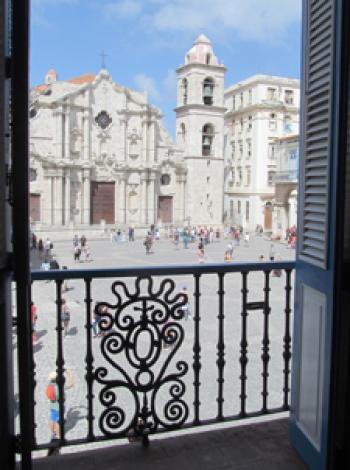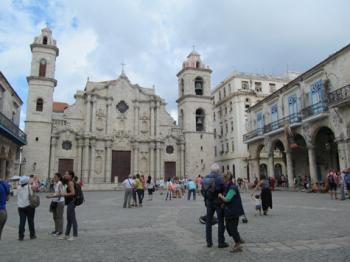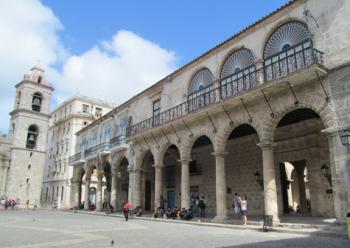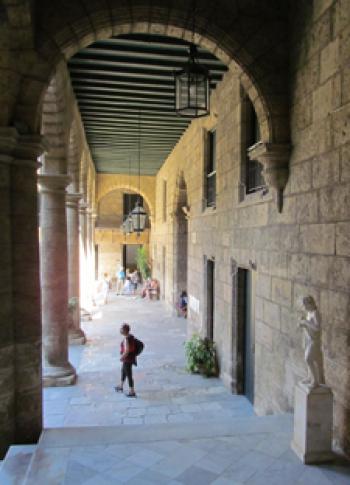Quartet of Old Havana plazas
This item appears on page 54 of the January 2018 issue.
Old Havana, on the Caribbean island of Cuba, is a city made for walking. Many of the streets are pedestrian-only, closed off to vehicles except for people-powered pedicabs. The streets in this oldest part of the city are crowded with locals, who live and work here, as well as with tourists.
Walking is by far the best way to experience a city, to notice the details that make it unique and to feel its day-to-day pulse. This is especially true for Old Havana.
Old Havana is centered on four plazas, each filled with historic and architectural gems, including renovated mansions as well as a few crumbling old beauties awaiting restoration.
These four plazas can be seen in one busy day or, better yet, spread out over several days if there is time, which is how my husband and I visited them in February 2017.
Oldest part of Havana
The oldest of the four plazas is Plaza de Armas, dating from the early 16th century. It stands at the northern limit of the oldest part of the city. Alongside is shady Parque Céspedes, centered on a statue of Carlos Manuel de Céspedes, who helped set Cuba on the road to independence in 1868.
Two outstanding buildings ring the park and plaza: the atmospheric 16th-century Castillo de la Real Fuerza, the oldest of four forts that once defended the city, and the Palacio de los Capitanes Generales, constructed in 1770, home to 65 Cuban governors from 1791 to 1898.
Its beautiful courtyard, enclosed by a loggia, is centered on a white marble statue of Christopher Columbus. It now houses the Museum of the City of Havana, with rooms displaying items from the city’s long history.
Heart of Old Havana
A 15-minute stroll away is the Plaza de la Catedral, where Havana’s cathedral as well as, arguably, the city’s richest assortment of historic buildings are located.
The most notable building here is San Cristóbal Cathedral, constructed by the Jesuits in the mid-18th century. Its exterior is in Baroque style, with two mismatched but attractive bell towers. Its interior is in a much simpler Classical style.
The ashes of Columbus supposedly rested in this cathedral for over 100 years (1795/1796 to 1899) until being returned to Spain. There is a continuing dispute about whether Spain has the “real” Columbus or whether he still rests in this cathedral, never having been transferred to Spain in 1899.
There is even a third option, that Columbus’s ashes, which were originally in Santo Domingo, capital of the Dominican Republic, were not the ashes that were sent to Havana in 1795. It’s a mystery that may never be solved.
The cathedral is in noble architectural company. To its left is the mid-18th-century Palacio de los Marqueses de Aguas Claras, occupied at one time by a descendant of Juan Ponce de León, who led expeditions to what is now known as Florida in 1513 and 1521. The Paris Restaurant now occupies the arcaded front portico of the mansion as well as its shady interior courtyard.
Across from this mansion are two buildings from the same era: the Palacio del Conde de Lombillo and the Palacio del Marqués de Arcos, reputedly built for Diego Peñalver y Angulo, the Spanish king’s royal treasurer in Cuba.
The two palatial houses share a common portico, which enhances the grandeur of each. The Casa del Marqués de Arcos has a lovely patio dotted with tropical plants.
Directly opposite the cathedral is the oldest building in the plaza. Palacio de los Condes de Casa Bayona, built about 1720, now houses the Museum of Colonial Art, with exhibition rooms encircling a peaceful central patio.
Religious art
One thing to look for in Old Havana are ancient seashells embedded in the stone blocks of the walls. These blocks were used in the construction of buildings, particularly in the vicinity of the next plaza, Plaza de San Francisco de Asís, about a 20-minute walk from the cathedral.
In the 16th century, this plaza was the city’s waterfront, which explains why the original Customs house was once located here as well as the later Customs house built in 1910. But it is the Church of San Francisco de Asís that dominates the plaza now, with the lovely Fountain of the Lions in the plaza’s center.
When we visited, a choral group was rehearsing for a performance that evening. Their voices reverberated through the church, adding to the feeling of “sacredness.” Concerts are often scheduled, with lists posted near the entrances. You might be lucky enough to hear one.
The church now houses the Museum of Religious Art, where the highlights of the collection, among many others, are bone fragments of Hernán Cortés, conqueror of the Aztec Empire in what is now Mexico, and of St. Francis of Assisi, each preserved in monstrances in the church’s nave.
Adjacent to the church is the small park dedicated to Mother Teresa of Calcutta, with her life-size statue seated within the garden and surrounded by tropical plants. Habaneros consider this a perfect spot to relax from the hustle and bustle of Old Havana.
Old plaza, new life
The last plaza we visited in Old Havana was Plaza Vieja, about 10 minutes from Plaza de San Francisco de Asís. It’s a large, open space dating from about 1559, with an impressive fountain in its center and dotted with contemporary artwork. It’s enclosed by dozens of restored, colonial-era buildings, many of which were once family mansions.
Over its long life, the plaza has been used as a military parade ground, bullfight venue and open-air market. It is now a center for restaurants, cafés, bars, boutiques and luxury apartments.
In the southeastern corner is the elaborate Palacio Cueto, one of the plaza’s most beautiful buildings, now in the process of being restored. It’s been compared to the buildings of the Barcelona architect Antonio Gaudí, but I think it is distinctly Old Havanan.
Palacio Cueto, built in 1906, has had many “lives” in its 111 years. It’s been a warehouse, a hat factory and a hotel. When finally restored, it will emerge from its scaffolding as a luxury hotel once again.
One other building that should be noted is on the southwestern corner of the plaza. It’s now the restaurant/pub Factoria, where beer is brewed on site and can be sampled at an outside table on the plaza.
If you go…
If you’re able to try these on your trip, here are a few of the restaurants we enjoyed in Old Havana:
El Globo, in Hotel Santa Isabel on the Plaza de Armas, for people-watching and for snacks.
Paris Restaurant, on the Plaza de la Catedral, for people-watching, for its location in a beautiful historic building and for snacks and light meals.
Doña Eutimia, in the Callejón del Chorro, just off the Plaza de la Catedral, for first-rate Cuban food plus mojitos and daiquiris. (Here, reservations probably need to be made three or four days in advance; the number to call is +53 7 801 3332 or +53 7 861 1332).
Floridita (supposedly one of Ernest Hemingway’s favorite café-bars during his long residency in or near Havana), at Obispo 557, for people-watching, daiquiris and light meals.
Julie traveled to Cuba independently, before President Trump reimposed restrictions on travel to the island by Americans. For more details about those restrictions, see this month’s “Boarding Pass” column. — Editor





